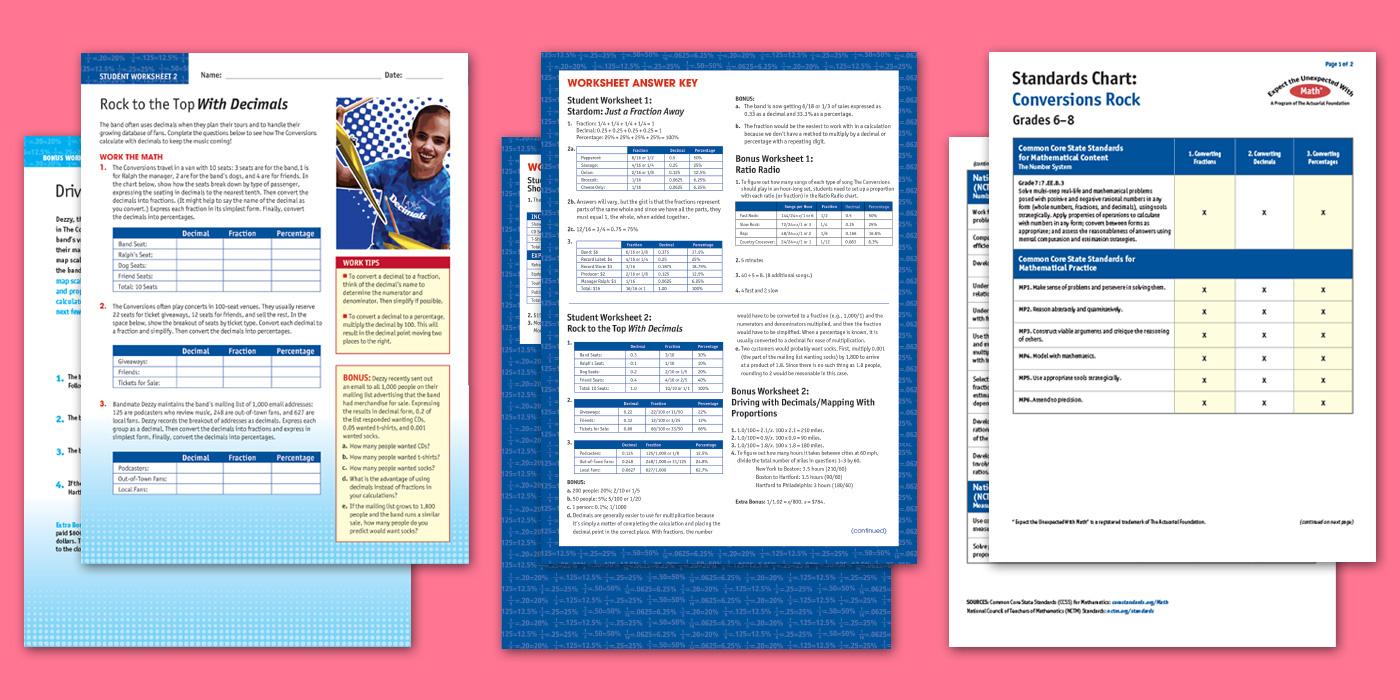How to Convert Decimals
In this lesson plan, students will learn the key features of decimals and how to convert them to equivalent fractions and percentages.
Preinstructional Planning
Objectives
Students will:
- Convert decimals to equivalent fractions and percentages
- Apply place value concepts to decimals
Materials
- Conversions Rock Worksheet: Rock to the Top With Decimals printable
- Conversions Rock Bonus Worksheet: Driving With Decimals, Mapping With Proportions printable
- Answer Key: Conversions Rock Worksheets printable
- Standards Chart: Conversions Rock printable
During Instruction
Set Up
- Make class sets of the Conversions Rock Worksheet: Rock to the Top With Decimals printable and the Conversions Rock Bonus Worksheet: Driving With Decimals, Mapping With Proportions printable.
- Print a copy of the Answer Key: Conversions Rock Worksheets printable for your use.
Lesson Directions
Introduction to New Material
Step 1: Ask students where they see decimals in everyday life. Examples might include money ($1.37), sports statistics (4.7 yards per carry), measurement (1.5 gallons), etc.
Step 2: Tell students that understanding the place value of decimals will help students better use these numbers in situations both outside of school (like the examples above) and in the classroom. Write a number on the board with four digits to the left of the decimal place and four digits to the right, such as 1,234.5678. Review the values of the places to the left of the decimal point, i.e., the value of the 1 is 1,000 because the digit 1 is in the thousands place, the value of the 2 is 200 because the digit 2 is in the hundreds place, and so on.
Step 3: Point out the value of digits to the right of the decimal point, i.e., the 5 is in the tenths place, the 6 is in the hundredths place, the 7 is in the thousandths place, and the 8 is in the ten-thousandths place. Highlight that the place values to the right of a decimal point end in the suffix -th (plural -ths). While the whole number "one hundred" means 100 wholes, the decimal "one hundredth" indicates 1 part out of 100 equal parts (e.g., 1 out of 100 parts of a dollar, or 1 cent).
Step 4: Write the following decimals on the board: 0.4, 0.57, and 0.125. Say the name of each decimal, i.e., four tenths, fifty-seven hundredths, and one hundred twenty-five thousandths. Point out how the name of each decimal tells us how to convert them to fractions: 0.4 = 4/10, 0.57 = 57/100, and 0.125 = 125/1,000.
Step 5: Point out that some of these fractions can be expressed in simplest terms: 4/10 = 2/5 and 125/1,000 = 1/8.
Step 6: Remind students that certain fractions do not convert into simple decimals. For example, 1/3 becomes 0.3 because that is the result of dividing 1 by 3.
Step 7: The term percent means “out of 100,” so to convert a decimal to a percentage, multiply the decimal by 100. This will always result in moving the decimal point two places to the right. Then add the percentage symbol. For example, 0.47 = 47%, 0.6 = 60%, and 0.375 = 37.5%.
Guided Practice
Step 8: Group students into pairs and ask them to convert the decimals 0.8, 0.14, and 0.002 to fractions and percentages. Then review answers with the class.
- 0.8 equals 8/10 (4/5 expressed in simplest terms) = 80%
- 0.14 equals 14/100 (7/50 expressed in simplest terms) = 14%
- 0.002 equals 2/1000 (1/500 in simplest terms) = 0.2%
Independent Practice
Step 9: Distribute the Conversions Rock Worksheet: Rock to the Top With Decimals printable for students to complete as classwork or homework.
Step 10: Check for Understanding: Review the worksheet answers with the class using the Answer Key: Conversions Rock Worksheets printable. Tip: Have students read their answers aloud. Hearing decimals read aloud reinforces how they convert into fractions.
Step 11: For additional reinforcement or practice, distribute the Conversions Rock Bonus Worksheet: Driving With Decimals, Mapping With Proportions printable. Review the worksheet answers with the class using the Answer Key: Conversions Rock Worksheets printable.
Lesson Extensions
Real-World Math Extension
One or both extensions could be used in conjunction with any of the three lessons in the Conversions Rock unit, as the teacher sees fit.
- Ask students if they can think of professions that involve math. Discuss with students what an actuary is. Actuaries use statistics in their job to calculate risks for many different industries, and they look at data in terms of fractions, decimals, and percentages. Actuaries also use ratios and proportions in predicting the likelihood of events. For example, by analyzing past experience, an insurance company determines that 1 in every 20 drivers will have an accident in a given year. If they insure 10,000 drivers this year, the insurance company can plan ahead and put aside money to pay for 500 accidents (based on the proportion 1/20 = 500/10,000).
- The Series of Unfortunate Events books contain types of events for which actuaries may estimate the likelihood of occurring. For example, they may find that 1/3 of all skiers have accidents. Or that 40% of all skydivers injure their feet. Or 0.20 of all residents in a Kansas town have experienced tornado damage. Can you think of other events actuaries might analyze?
Post Instructional
Standards
- Grade 7: Multi-Step Real-Life Problems With Decimals, Fractions, and Whole Numbers (CCSS 7.EE.B.3)
- Grade 6–8: Constructing an Argument, Modeling, Using Appropriate Tools, Attending to Precision (CCSS MP3–6); NCTM Number and Operations
For more information, download the comprehensive Standards Chart: Conversions Rock printable.



